|
Cane River Creole National Historical Park is home to many species of birds, with relatively mild winters, many of these species can be seen year-round, but their numbers increase with migration periods.

USFWS Photo White Pelican Pelecanus erythrorhynchosThe state bird of the Louisiana, the White Pelican, is one of the largest North American birds. Majestic in the air, the birds soar on broad black-and-white wings. White Pelicans eat mostly small fish in shallow wetlands. Sometimes, groups work together to heard fish into the shallows where they can easily scoop the fish up into their pouched bills. 
USFWS Photo: Rinus Baak Great Blue Heron Ardea HerodiasThe Great Blue Heron is the largest of the North American Herons with long legs and neck and a thick, daggerlike bill. These large blue-gray wading birds stand nearly four feet tall, and have 72-inch wingspans. A common site along rivers, lakes and bayous, Great Blue Herons spear and swallow whole everything from fish to frogs to snakes to rodents. In flight, the Great Blue Heron can be identified by the tucked-in neck and trailing long legs.
USFWS Photo Bald Eagle Haliaeetus leucocephalusOur national symbol, distinguished by a white head and white tail feathers, are powerful brown birds that may weigh 14 pounds and have a wingspan of 8 feet. Bald Eagles can be seen most frequently near rivers and lakes where they can find fish, their staple diet. However, Bald Eagles will also feed on waterfowl, turtles, rabbits, snakes, and other small animals and carrion.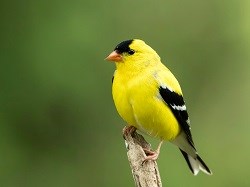
NPS Photo: N. Lewis American Goldfinch Spinus tristisAdorned with feathers of bright yellow and shiny black, everything about the goldfinch is meant to show off. Its calls are loud squeaky whistles. It flies with a bouncy acrobatic style. It poses dramatically on branches and bird-feeders. The goldfinch is a strict vegetarian. Seeds make up the majority of its diet. Rarely hidden in the deep forests, the goldfinch prefers open fields and meadows where it can see and be seen.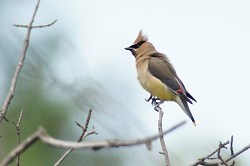
NPS Photo Cedar Waxwing Bombycilla cedrorumCedar Waxwings are characterized by their brown, pale gray and lemon-yellow coloring with silky feathers, accented with a subdued crest, black mask, and brilliant-red wax droplets on the wing feathers. Seen mostly in February or early March, the Cedar Waxwing is one of the few North American birds that specializes in eating fruit. These very social birds gather by the hundreds to eat berries, filling the air with their high, thin, whistles.
NPS Photo: Bryce Robinson Red-tailed Hawk Buteo jamaicensisProbably the most common hawk in North America, Red-tailed Hawks occupy just about every type of open habitat on the continent. Red-tailed Hawks soar above open fields, slowly turning circles on their broad, rounded wings. Other times you’ll see them atop poles or posts, eyes fixed on the ground to catch the movements of a vole or a rabbit. Mammals make up the bulk of most Red-tailed Hawk meals. In addition to voles and rabbits the hawks also eat mice, squirrels, and birds; as well as snakes and carrion.
NPS Photo Barred Owl Strix variaHighly vocal, the Barred Owl is easier to hear than to see. Its easily recognizable call is described as "Who, cooks, for-you? Who, cooks, for you-all?" The Barred Owl is a medium-sized grayish-brown owl with a large head and streaked with white horizontal strips or barring on its chest. Its eyes are dark brown. The barred owl is a very opportunistic hunter and can sometimes be seen hunting before dark. They hunt by sitting and waiting on an elevated perch. Voles, shrews and mice are its main prey. Other prey includes rats, squirrels, small rabbits, bats, moles, small snakes, frogs, large insects and the occasional bird.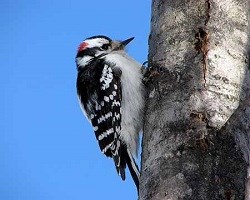
USFWS Photo: Peter de Wit Downy Woodpecker Dryobates pubescensDowny Woodpeckers hold the distinction of being the most common and smallest American woodpecker. "Downys" are between 6 and 7 inches in length with wingspan between 10 and 12 inches. Drumming is one of the unique characteristics of woodpeckers. Woodpeckers don’t sing songs, but they drum loudly against pieces of wood or metal to achieve the same effect. While drumming is needed to create a nesting cavity or find insects under bark, male woodpeckers also drum to establish a territory and maintain dominance afterwards. Woodpeckers have a shock-absorbing system in their heads that prevents their brains from slamming into their skull. Additionally, their skulls are heavier than most birds’ to withstand the repeated impact. Downy Woodpeckers feed on insects and grubs which they find under bark, on plant stems, and in galls of trees. A smaller part of their diet is composed of fruit and seeds.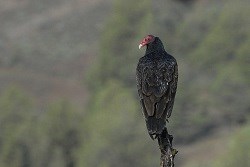
USFWS Photo Turkey Vuture Cathartes auraTurkey Vultures are dark brown with a featherless red head and pale bill. Vultures are a consummate scavenger, cleaning up the countryside as a member of nature's clean-up crew, and have several adaptations for their role. They use a keen sense of smell to locate fresh carcasses. Once food has been found, they use their sharp, hooked bills to eat. The vulture's featherless head helps keep them clean. Vultures are very efficient fliers, using thermal updrafts to carry them into the sky and soar for long distances.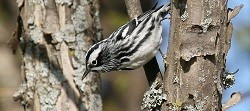
USFWS Photo: Katie Koch A Black-and-white Warbler Mniotilta variaAdapted to creeping along limbs and on tree trunks to feed, the Black-and-white Warbler climbs about on the trunks and major limbs of trees, seeking insects in the bark crevices. These birds have an extra-long hind claw and heavier legs than other wood-warblers, which help them hold onto and move around on bark. Their song is thin, almost squeaky, but penetrating, so it’s a good way to find them. You typically see Black-and-white Warblers only in trees, however, they build their little cup-shaped nests usually on the ground.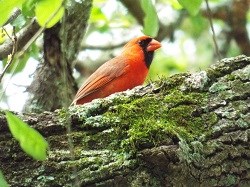
NPS Photo: Beau Graff Northern Cardinal Cardinalis cardinalisMale Northern Cardinals are bright red all over, with a reddish bill and black face around the bill. Females are pale brown overall with red accents in the wings, tail and crest. They have the same black face and reddish bill. Northern Cardinals tend to forage on or near the ground, often in pairs. The large bill is especially useful in crushing seeds. Northern Cardinals also eat fruits and insects. Cardinals will mate for life and stay together throughout the year.
NPS Photo: Gordon Dietzman Rock Dove/Pigeon Columba liviaThis dove has many common names: pigeon, rock dove, rock pigeon, racing pigeon, homing pigeon, domestic pigeon, among others, but rock pigeons are actually doves. Commonly, the word "pigeon" is used with the larger doves while the term "dove" is usually reserved for the smaller and more delicate birds of this group. Rock pigeons were introduced to North America from Europe in the early 1600s and are now widely spread across the continent. This familiar bird has had long had a relationship with humans who have used them for food (squab), to carry messages (carrier pigeons), and for recreation (homing pigeons and the breeding of fancy pigeons). Oakland and Magnolia Plantations both feature Pigeonniers (pigeon houses) where the birds were raised for food. 
NPS Photo: Beau Graff Eastern Bluebird Sialia sialisThe small, brightly colored Eastern Bluebird can be seen perched on wires and fence posts overlooking open fields. Insects, including caterpillars, beetles, crickets, grasshoppers, and spiders, are a bluebird's main food for much of the year. Bluebirds can spot their tiny prey from 60 feet or more away and flutter to the ground to catch the insect. In fall and winter, bluebirds eat a variety of fruit, including sumac, hackberries, and juniper berries.
USFWS Northern Bobwhite Colinus virginianusBobwhite are small quail with rounded bodies, small heads, rounded wings, and short tails. They are difficult to spot due to patterned feathers of brown, rufous, buff and black. However, the call, two sharp whistled notes that do sound like bob-white, carries a long distance. Bobwhites travel in groups, running across the ground from the shelter of one shrubby area to another. If alarmed Bobwhites burst into flight and then duck to nearest cover.
USFWS Photo: Marc Epstein Painted Bunting Passerina cirisAdult male Painted Buntings are unmistakable with their combination of red, blue, green and yellow feathers. Females and immatures are a uniform, bright yellow-green overall, with a pale eyering. Although both males and females have a metallic "chip" call only the male birds sing. Painted Buntings eat seeds for most of the year, switching to insects, including grasshoppers, beetles, wasps and flies, during breeding season.
USFWS Photo Tufted Titmouse Baeolophus bicolorThe Tufted Titmouse is a small soft silvery gray bird with an echoing voice. You will often hear the high, whistled peter-peter-peter song well before you see the bird. The pointed crest and stout bill also help identify titmice.
NPS Photo: Beau Graff Northern Mockingbird Mimus polyglottosSlender-bodied gray birds, the Northern Mockingbird, may be identified by listening for its song which usually mimics numerous other birds at once. These birds sing all through the day, and often into the night. Northern Mockingbirds continue to add new sounds to their repertoires throughout their lives. A male may learn around 200 songs throughout its life. Northern Mockingbirds eat mainly insects in summer but switch to eating mostly fruit in fall and winter. 
NPS Photo: Beau Graff Blue Grosbeak Passerina caeruleaBlue Grosbeak is a stocky songbird with a very large, triangular bill that seems to cover its entire face. Males are deep blue with chestnut wingbars. Females are cinnamon with brown wingbars. Although they feed mostly on insects (especially grasshoppers and crickets), Blue Grosbeaks also eat other invertebrates such as snails, along with the seeds of wild and cultivated grains.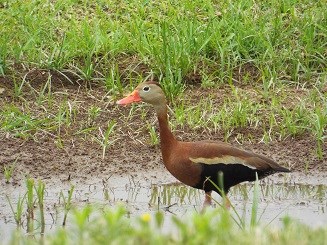
NPS Photo: B. Graff Black-bellied Whistling-Duck Dendrocygna autumnalisA spectacularly marked, sociable, noisy waterfowl. Often rests on low snags above water, and may perch high in dead trees. In North America found mostly near Mexican border, but has increased in numbers. Flocks come to harvested fields to feed on waste grain, also to prairies and overgrown pastures. In shallow water may wade to reach emergent plants, or may dabble at surface or tip up to reach under water. |
Last updated: May 15, 2022
